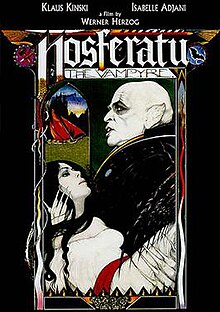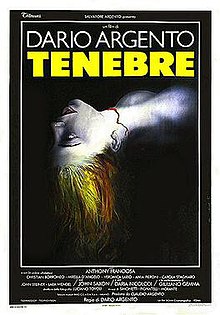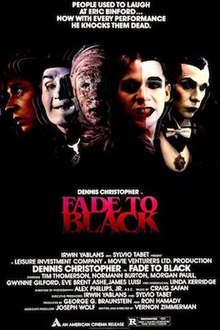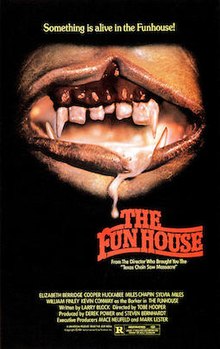We’re now two weeks into the swing of things here, and we get yet another appearance from Darren Lynn Bousman, director of such AoG memories as Repo! The Genetic Opera, the two Devil’s Carnival films, Mother’s Day, and Abattoir, along with the second, third, and fourth installments of the Saw series. Dude’s been around, and here he’s just one of ten (!) directors involved in the 2015 anthology film Tales of Halloween, a film jam-packed with actors, directors, and references to the horror genre’s varied past.

The film kicks off with Adrienne Barbeau as a DJ on the radio, sorta spinning some vague tale of creepiness and whatnot (my mind wanders to Angela Davies’s Veronica on Best Sex Ever), the first of many references to horror master John Carpenter littered throughout the film, Barbeau having starred in Carpenter’s The Fog as, you guessed it, a DJ. (There are also several Catwoman references in the film, possibly alluding to Barbeau’s recurring role as Catwoman on Batman: The Animated Series.) Things then truly get started with our first tale, “Sweet Tooth”, from writer/director Dave Parker (who, funnily enough, co-directed Kraa! The Sea Monster back in the day). The story is the usual horror fare about a kid being told a scary story that happens to immediately turn out to be true. Appearing here are Caroline Williams (from Texas Chainsaw Massacre II, Stepfather II, and Rob Zombie’s Halloween 2), Robert Rusler (from A Nightmare on Elm Street 2 and Amityville: A New Generation), Clare Kramer (The Gift), and Greg Grunberg (Hollow Man). Next up is “The Night Billy Raised Hell” from Bousman and writer Clint Sears, which tells the tale of a wussy little boy who meets the devil on Hallowe’en, who purportedly shows him how to really raise hell while out trick-or-treating. Barry Bostwick (“Dammit, Janet!”) is the star power here, and he looks like he’s having a ball. Next is “Trick”, wherein a group of adults gets unexpectedly hacked up by some trick-or-treaters. Appearing here are Tiffany Shepis (an old Troma staple who went on to score roles in plenty of low-budget stuff like Sharknado 2 and Victor Crowley) and Trent Haaga (Starry Eyes and Citizen Toxie, among plenty others). Next is “The Weak and the Wicked”, directed by Paul Solet (Grace), about a man who summons a demon to deal with a trio of hoods who’ve hassled the weak over the years (as well as torching his family’s caravan, Brick Top style). Here we see Keir Gilchrist (It Follows and Dead Silence), Booboo Stewart (Seth from the Twilight series), Noah Segan (Cabin Fever 2 and the voice of Henry from Nickelodeon’s KaBlam!), and segment highlight Gracie Gillam (from the Fright Night remake). Next is “Grim Grinning Ghost”, chronicling a young woman beset by the vengeful spirit of a disfigured woman. This one’s loaded with history-makers, including a We Are Still Here reunion between Barbara Crampton and Lisa Marie, Lin Shaye (Ouija and the Insidious series, among many others), Mick Garris (director of Critters 2 and Psycho IV and writer of The Fly II and Hocus Pocus), and Stuart Gordon (acclaimed writer and director with credits including Re-Animator, From Beyond, Honey, I Shrunk the Kids, and the 1991 The Pit and the Pendulum), though the furry little Anubis nearly steals the segment with his canine cuteness. Next is “Ding Dong”, written and directed by Lucky McKee (Red, May, and The Woman), giving us the story of a couple who are unable to conceive a child and dealing with the stress that brings to the wife on Hallowe’en night. Featured here are Marc Senter (Starry Eyes, Cabin Fever 2, and the Scorpion from the aforementioned Devil’s Carnival films), Felissa Rose (the original Angela from Sleepaway Camp), the adorable French bulldog Lilly von Woodenshoe, and the deliciously over-the-top (and segment salvaging) performance of Pollyanna McIntosh (The Woman and The Walking Dead). Next up is “This Means War”, co-written and -directed by John Skipp (A Nightmare on Elm Street 5 and Class of 1999), which tells the story of a culture clash turned violent when differing methods of celebrating Hallowe’en collide. It starts off like a pantomime, and I was vainly hoping it would stay that way. Alas. Appearing here are James Duval (The Doom Generation, Independence Day, and the man who played Frank in Donnie Darko), Elissa Dowling (Party Bus to Hell, Starry Eyes, and Transmorphers), and Frank Dietz (The Lost Skeleton Returns Again and an in-between animator for Disney during the latter years of the Renaissance period). Next is “Friday the 31st”, from writer/director Mike Mendez (Lavalantula, Big Ass Spider!, and the editor of this here film) and co-writer Dave Parker, a take-off on the indestructible slasher film from the 80s that gets hijacked by aliens. It’s not quite as fun as it sounds. Appearing are Nick Principe (Lavalantula and ChromeSkull from the Laid to Rest series) and an adorable little claymation-looking animated alien critter. Penultimately up next is “The Ransom of Rusty Rex”, wherein a couple of hoods kidnap the son of a wealthy man hoping to score some ransom money, only to find the child is really a sort of demon creature. Always the way, ain’t it? Appearing here are John Landis (director of many classics, including An American Werewolf in London and the first segment of Twilight Zone: The Movie) and Sam Witwer (The Mist). Finally, we have “Bad Seed”, written and directed by Neil Marshall (Dog Soldiers, Doomsday, and The Descent), which tells the story of a killer jack-o-lantern. Appearing herein are Cerina Vincent (Cabin Fever), Kristina Klebe (Rob Zombie’s Halloween and Geraldine from Alleluia! The Devil’s Carnival), Pat Healy (Starry Eyes, Dirty Girl, and Magnolia), Joe Dante (director of such films as Gremlins and The Howling), and acclaimed poster artist Drew Struzan, who makes what is likely the funniest joke in the whole damned production.
Now, that may have sounded like a list of thin plotlines/setups and a bunch of references, both to other movies and to previous AoG entries, and you’d be right in saying so. But, frankly, that’s what the movie basically boils down to (minus any mentions of this here ramshackle operation, natch). Most of the segments are decent as ideas or as quick visual gags for shows like Robot Chicken, but they barely carry long enough to fill out even their short time slots here. “Sweet Tooth” is probably the best-executed overall of the bunch, getting its simple point across quickly, efficiently, and effectively, and featuring some solid practical effects. Both “The Night Billy Raised Hell” and “Bad Seed” are fun, but suffer from some tonal issues (the goofy sound effects undermine things in the former, and the dorky premise of the latter clashes with its almost-serious tone just a bit too much than obviously intended). The rest are flimsy and often dull.
The film as a whole suffers from its apparently low budget, with some shoddy visual effects (including some cheap-looking CG work and puppetry and plenty of makeup and masks that just plain seem unfinished, often disconnecting from the actors’ faces during their line reads), plenty of wilhelm screams, and some wildly uneven acting: Bostwick is awesome in his role, but Vincent, for example, just looks tired and barely invested. The cinematography is overly clean and sterile throughout, wiping away many of the directors’ characteristic quirks and making the whole enterprise look mass-manufactured and lifeless. Nothing sticks, and I’m not likely to remember many of these stories when I wake up tomorrow morning. Shit, there isn’t even any real connective tissue between the segments aside from Barbeau’s disembodied and nearly completely pointless voice; they’re just ten stories set on Hallowe’en and told together.
And that’s ultimately the film’s main failing: it’s just nothing special enough to remember or thoroughly enjoy. In a world that already has plenty of great anthology films like Twilight Zone, Creepshow, and, most appropriate here, Trick ‘r Treat, there’s really no need for a lackluster reference fest like this, sadly.









